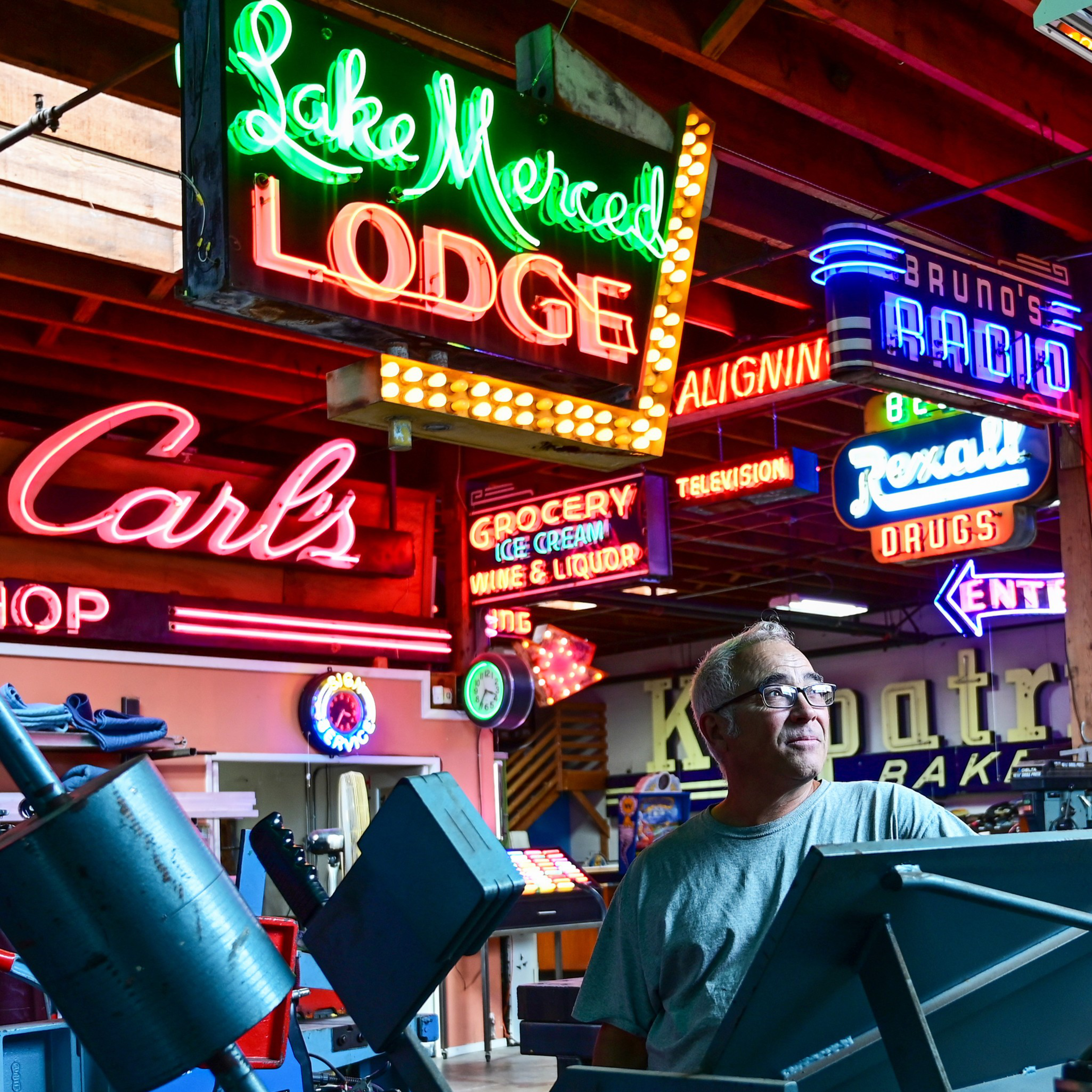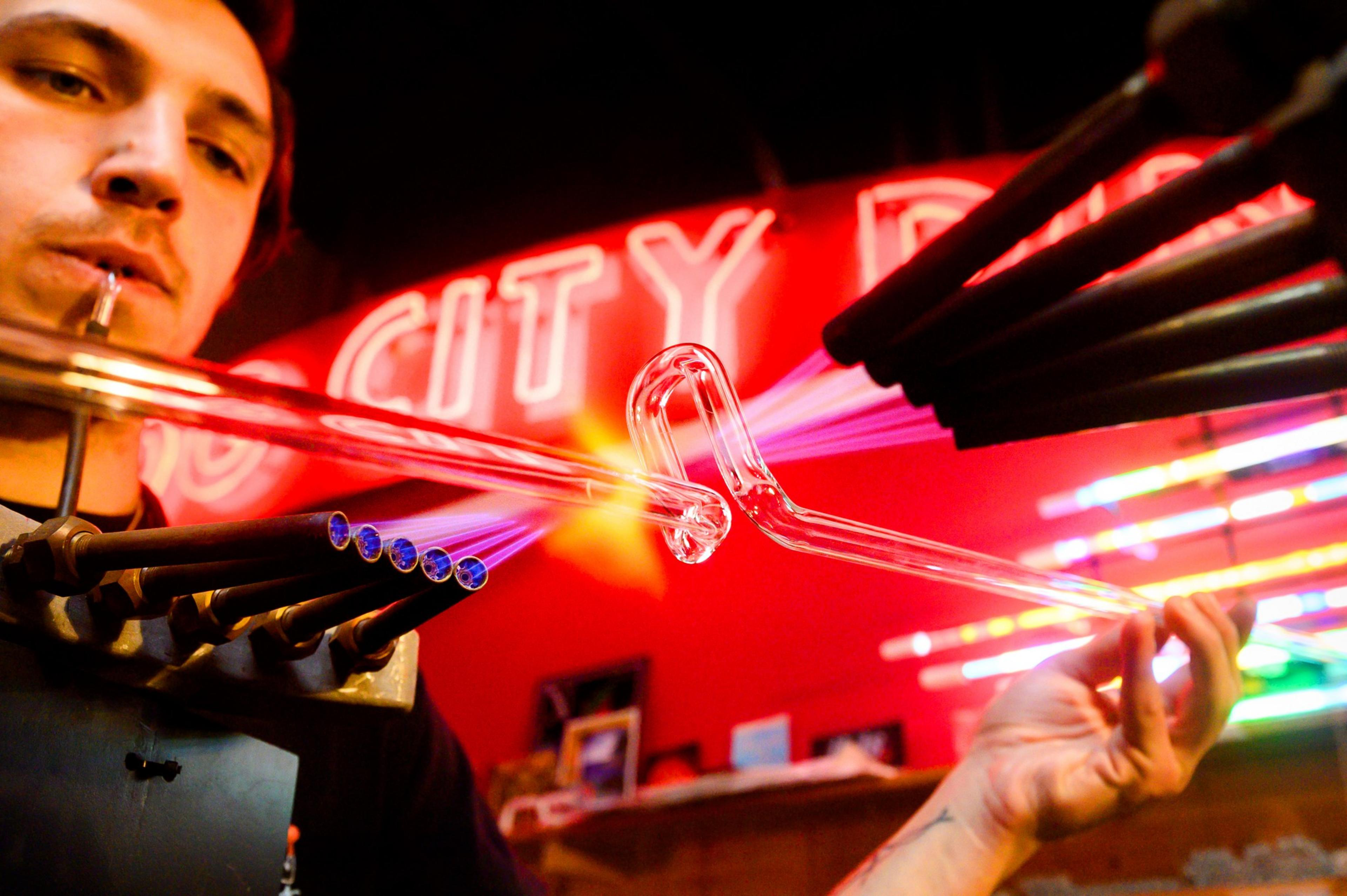From the Buddha Lounge to the House of Shields, Tommy’s Joynt to Bimbo’s 365 Club, neon light bathes San Francisco in a cinematic glow. It’s no coincidence that movie palace “blades”—those vintage vertical signs that announce the Castro Theatre, the 4-Star or the Alamo Drafthouse—are each built from neon, too.
Fundamentally simple signs declare a place’s purpose—a liquor store, an old-school hotel, even a humble shoe repair shop or check-cashing place. But the city is replete with more elaborate examples: the blinking martini glass of the Mission District dive the 500 Club, the three-dimensional lantern illuminating Chinatown’s Li Po Lounge and the sprawling expanse of “Hills Bros. Coffee” over the Embarcadero.
Neon is in the city’s blood. Macy’s in Union Square once ordered a quarter-million dollars worth of neon for its holiday display—only to throw it all away five years later. The more you start looking for neon in San Francisco, the more you notice. Simple and small or large and in charge, neon has personality—and you can thank one company in particular that so much of it is still gleaming.

Neon Works has been in business (opens in new tab) for 33 years, and it’s the last company of its kind in the Bay Area. While other local sign shops do neon—Arrow, Thomas Swan and YESCO among them—they only produce a small fraction, whereas Neon Works owner Jim Rizzo works on nearly nothing else in his 17,000-square-foot facility in Oakland.
“It’s all we do, and we can do it all,” Rizzo said.
Neon Works maintains some of the most iconic signs in the city—including the Castro Theatre’s, which the company typically services twice a year—and crafts artistic works, like the neon sculpture “Taotie” by Kongkee (opens in new tab) on the roof of the Asian Art Museum and the “Weirdly Lovable, Lovably Weird” sign in its Takashi Murakami exhibition.

From the 1920s through the 1960s, neon signs blazed all over the city—nearly the entire length of Market Street and much of Broadway—the displays becoming ever more elaborate as businesses tried to compete for attention with their radiant fixtures. But today, the Odd Fellows Hall on Seventh Street is one of the few remaining blades on Market, and apart from the Condor Club and a handful of other strip joints, Broadway has lost many of its leggy displays.
Cheaper to build, maintain and power with electricity, light-emitting diodes (or LEDs) began replacing neon in the 1970s. But while LEDs might be practical, they lack the character of their neon forebears.
“A chimpanzee can put together LEDs,” Rizzo said.
Neon, unlike LEDs, requires years of training and deft skill—even as the process of making it has remained virtually unchanged for over 100 years. There’s a steep learning curve to becoming a glass bender.
“I’ve been doing it for seven years, but I’ve been good for three,” said Adam Taylor, who has worked at Neon Works since 2020.
It typically takes about five years of practice before a glass bender can ply their trade effectively, and the intense concentration and focus necessary to do the work creates a type of flow state.

“It’s hard to bend angry or tired or in a bad mood,” Taylor said.
It all starts with a 4-foot tube, which may have a phosphorescent coating to create a range of colors from yellow to turquoise to violet. Using a paper pattern laid out in reverse so the lettering faces forward, the glass bender marks the tube and heats it over a burner until it bends easily. All the while, the glass bender is blowing through the tube so it holds its round shape and doesn’t collapse onto itself. Glass is a fickle medium.
“It’s like a wet noodle,” Taylor said.
The tube must have a perfect vacuum, achieved through a device called a bombarder, and is filled with a noble gas, typically neon or argon. Noble gases may be chemically inert, but when zapped with electricity, they come alive with color. (Neon creates warm red, while argon creates blue.) The segments of the lettering that aren’t intended to glow receive a black coating at the dipping tank, and a transformer is assembled to run electrodes through the gas. For traditional signs, a metal backing or “tin can” is assembled and painted before installation.
Only then is the sign ready to breathe new life—which also happens to be composed of gases we breathe in and out every day—into businesses like the St. Francis Fountain or Bimbo’s 365 Club.
Neon Empowered
“Neon is alive,” said graphic designer Randall Ann Homan. “It’s a Frankenstein of energized particles.”

Homan’s love of neon has led her and her partner, Al Barna, to advocate for its preservation—and their efforts are paying off.
Even with neon’s half-century decline, San Francisco has started to hold tight to its survivors—in 2022, the Board of Supervisors passed legislation to protect the Tenderloin’s impressive array of glowing signs. The decision came in part thanks to Homan and Barna’s advocacy.
Barna and Homan—who have published four books about neon and run the organization San Francisco Neon (opens in new tab)—were first bitten by the bug when the over-the-top Hunt’s Donuts sign (opens in new tab) at Mission and 18th streets (“Open 25 Hours”) came down.
“We realized the signs we love in the city won’t be around forever, and we better start documenting them,” Homan said. Everyone was as excited as they were. When they began a Kickstarter campaign to fund their first book, they matched their goal in two weeks.
“That was the big door prize,” Homan said. “We gained a community that cared about preserving signs.”
The couple’s love of the glowing gas inspired them to start Neon Speaks (opens in new tab), an annual festival and symposium dedicated to neon. Barna and Homan conduct walking tours (opens in new tab) in some of the most neon-heavy neighborhoods—the Mission, the Tenderloin and Chinatown—which typically sell out a month in advance. A new tour of the Mission they’ve added to their roster will help support the restoration of the Roxie Theater sign (opens in new tab).

Even as neon signs keep disappearing, Barna and Homan are fighting against that trend by supporting the preservation of vintage signs and the creation of new ones. A recent collaboration between San Francisco Neon and the Tenderloin Museum resulted (opens in new tab) in a new 25-foot blade sign inspired by the Cadillac Hotel that was illuminated for the first time (opens in new tab) just this month.
“There might be more neon signs in San Francisco than there are in Manhattan,” Barna said.
Once historic corridors for neon—New York’s Times Square, the Las Vegas Strip—have virtually none anymore, although the latter has morphed into the Neon Boneyard (opens in new tab).
“Attitudes at City Hall have changed towards neon,” Barna said. “For years, it was considered a sign of blight and neglect, but now people realize there’s a history and artistry in that they are all handmade.”
Barna and Homan surmise that San Francisco has been lucky because so many of its vintage neon signs are in neighborhoods already deemed historic and they—and their legacy businesses (opens in new tab)—are more likely to be preserved. Rizzo has a simpler explanation: Neon may be expensive, but there’s enough money floating around San Francisco to keep it lit.

Whatever the reason, the neon-obsessed—of whom there are many—are thrilled to see so many sidewalks awash in the atmospheric illumination of noble gases.
“The best way to keep those neon signs glowing,” Homan said, “is to become a customer of the business that has one.”
